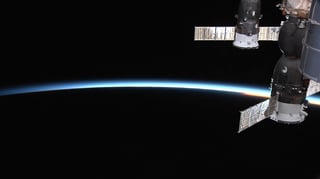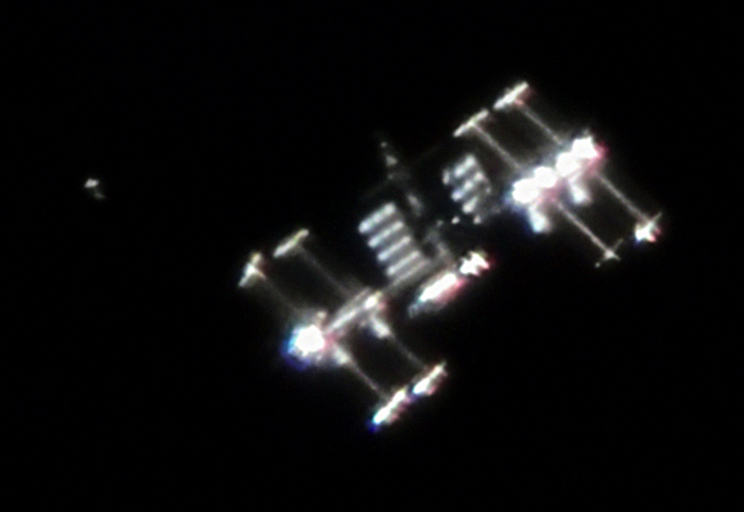There are a few positional lights on the visiting spacecraft to the International Space Station (ISS), also doubling as indicators that the visiting spacecraft docked to the station are powered and similar reasons. And the Canadarm2 has lights on it so it can be remotely / CCTV operated also when the station is in the Earth's shadow, and they do have lights inside the station so astronauts / cosmonauts can see, and some of this light would be reflected towards the Earth when someone is in the Cupola pointing towards nadir and its protective shutters are open. But none of these lights are nearly as powerful enough to see them from at least 410 km (254 miles) which is station's current orbital altitude and would be the minimum distance between you and the station when it orbits directly overhead from the observer, and most of them do blink.
What you can see from the ground is however this:

What's perhaps not best known is that the station's solar panel arrays are double-sided to also collect some of the sunlight reflected off the Earth's albedo (what our planet reflects from the Sun). They generate roughly up to 120 kW of power (on average about 84 kW) needed by the station's large number of equipment, life support, experiments,... to function. It stores excess collected power in batteries for when the station doesn't generate electric power with its photovoltaics (that's where that average comes from, lower than its maximum output), but more importantly to your question, they're roughly the size of a U.S. football field:

Image source and credit: International Space Station - Facts and Figures
So what you see is indeed as @GWP mentions in his/her answer, even if that started as a rather vague one-line answer. How can we be sure? Simple. The station simply doesn't have sufficient power to run any such lights powerful and large enough to be seen from the ground, as even at 100% efficiency they would consume roughly the same amount of power that the station generates at its own photovoltaics efficiency of well under 50% (yes, they're due for an upgrade if they want to run it till 2024 and run even more experiments). The rest of the incident light from the Sun is mostly reflected, and some absorbed as heat that needs to be radiated to space. But you'd want as little of this heat absorption, since convective heat transfer doesn't really work in the near vacuum in the Low Earth Orbit (LEO), so the solar arrays use coating that matches its efficiency and reflects the rest in wavelengths it's not as efficient in converting incident sunlight into electricity. And if it can utilize less than 50% of what light it has available to it and reflects as much as possible of the rest,... well, you can do the maths.
The light you see is sunlight reflected off the station's enormous solar power arrays, and can only be visible when the observational conditions are dark enough that the bright spot of the station isn't lost in the sunlit background, and the arrays reflect sunlight towards you, so when the station is not in Earth's shadow. When the station is barely entering the Earth's shadow, and if it was visible before it, you can also visually observe it slowly fading into the shadow with your own eyes. That's another proof that it doesn't keep lights strong enough to be seen from the surface on, if the fact that there's absolutely no good reason to do that isn't good enough of a proof on its own.
Here are four frames from the station showing two Soyuz spacecraft docked to it entering the Earth's shadow as seen from one of the ISS HD Earth Viewing Experiment aft facing cams (click on images for larger versions):




This happens about every 93 minutes on the station, or each time it completes one of its orbits. Except during the period of station's high beta angle when it might not enter Earth's shadow at all and its orbit remains more or less aligned with the Earth's day/night terminator for a few days or so. For more on all of this, read e.g.:
OK, so why white if the station's solar arrays reflect brownish-golden color on their own? Simply because of the intensity of reflected sunlight when compared to the darker background of dusk or dawn when the station can be seen with a naked eye. When the station is in the process of entering Earth's shadow and/or its beta angle (the angle between the Sun, the station, and the observer) is shallower, and the station's solar arrays are rotated to collect as much sunlight so towards the Sun, the amount of this reflected light will also be smaller, the light beam will also lose some of its intensity through the atmosphere through a process known as atmospheric diffraction (see the other linked question), and your eyes will be able to distinguish colors more precisely. It will also appear a bit more yellowish at those times.
To somewhat reaffirm my last point, consider this frame capture from the ISS HD Earth Viewing Experiment showing solar arrays on two Soyuz visiting spacecraft docked to the station and reflecting incident sunlight at different angles:

As you can see, the solar panels are actually not white, but due to the intensity of reflected sunlight, the array of the foremost Soyuz spacecraft appears bright white. It's not exactly white as neither the average wavelength of the light emitted by our Sun by intensity is, and the reflected light does include color component of the materials used on the panels, but for all intents and purposes, it's close enough.







